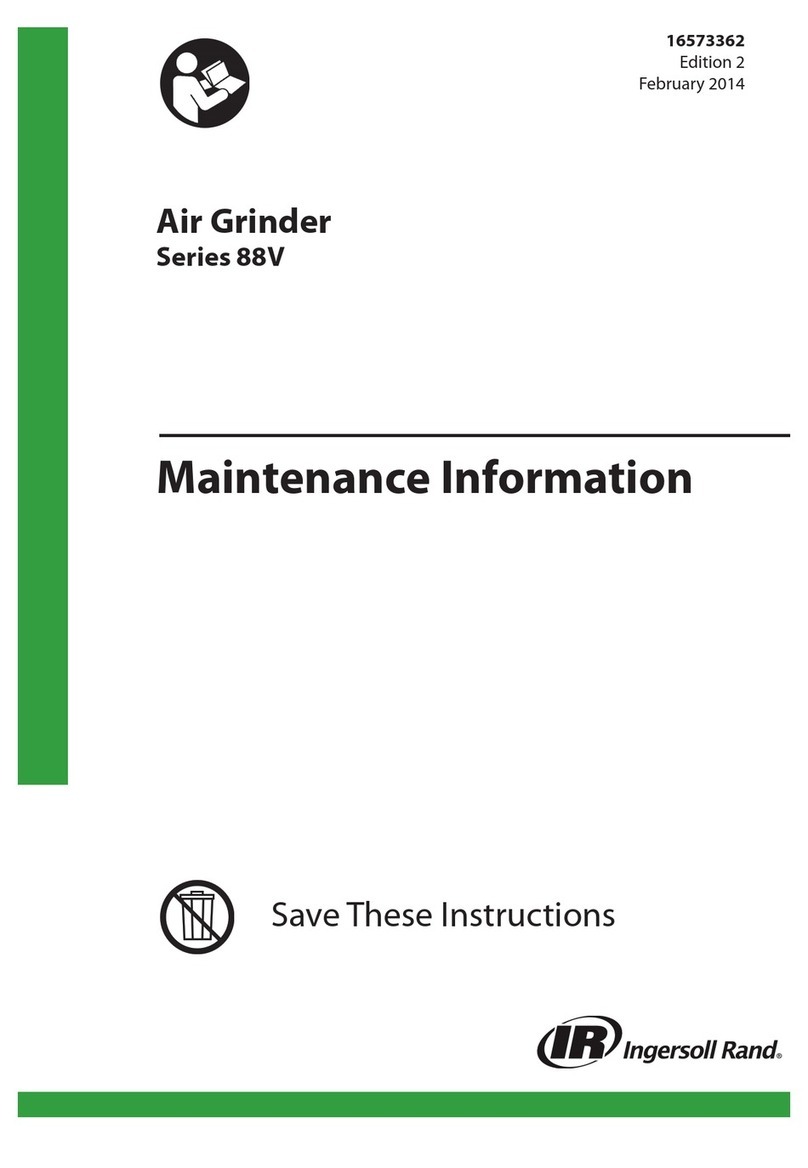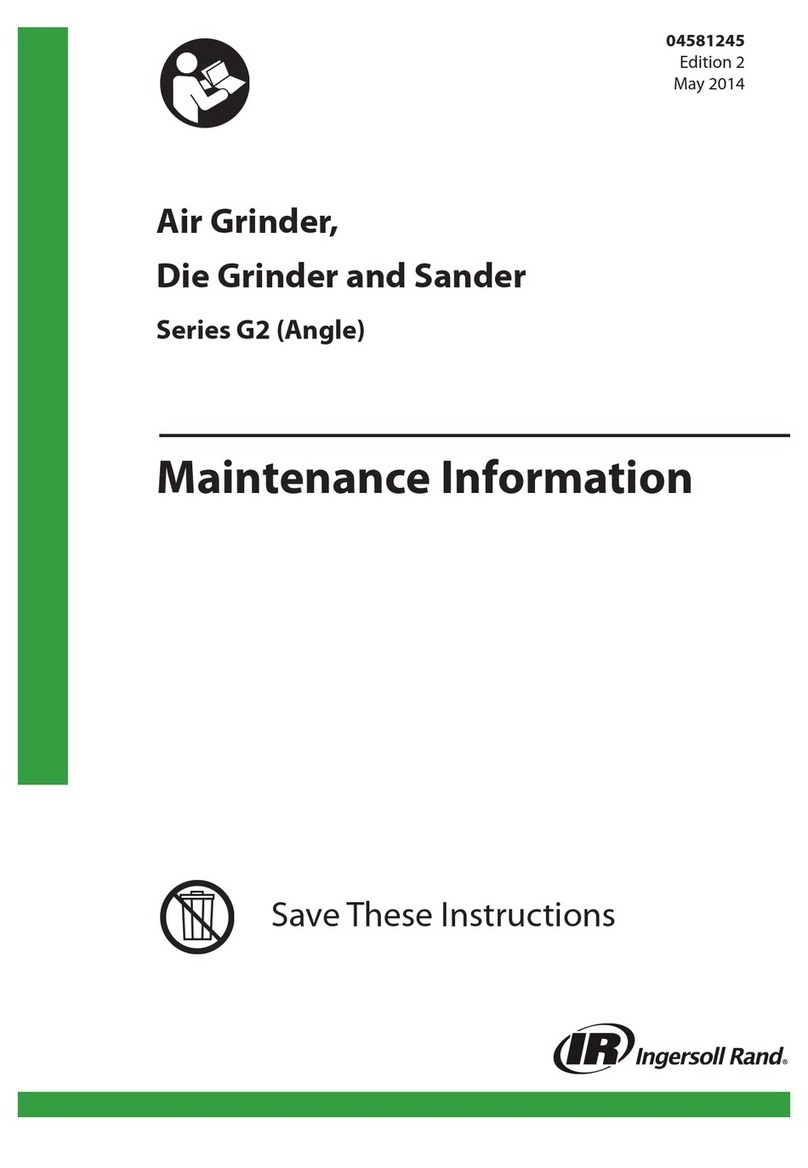
Assembly of the Throttle and Inlet
If the Ball Valve Seat was removed, use a 5/8”wooden dowel with
a at end to push the Seat into the Cylinder.
Assemble Throttle Pin O-Ring (20) onto Throttle Pin (21).
Using needle nose pliers, grasp Throttle Pin above O-Ring and
insert into threaded end of Cylinder. Align Pin with holes in
Cylinder and Housing and insert. Release Throttle Pin and push it
the rest of the way into the hole.
Insert the Ball (4) and then the Ball Valve Spring (3) small end rst
into the Cylinder opening.
Assemble Lever Support (6) into Rear Exhaust Diuser (5), the
U shaped side of support inserted rst into front of the Diuser.
Slide tabs into the slots on the Diuser and line up the holes with
the holes in the Diuser.
Assemble Rear Exhaust Diuser Gasket (8) onto Rear Exhaust
Diuser and assemble Diuser onto the Housing Assembly.
Align hole in Lever Assembly (9) with hole in Exhaust Diuser and
press the Throttle Lever Pin (7) through Exhaust Diuser holes.
Push the Inlet Screen closed end leading, into the large end of the
Inlet Assembly (1), until it is past the threads inside of the Inlet.
After lubricating the Inlet Seal (2) with O-Ring lubricant and being
careful not to nick the Seal on the threads of the Inlet, install the
Seal on the Inlet.
Thread the Inlet Assembly into the Cylinder and tighten it
between 20 to 25 ft–lb (27.1 to 33.9 Nm) torque.
Assembly of the Motor
If the Rear Rotor Bearing (28) was removed, stand the Rotor (29)
upright on the table of an arbor press with the threaded end
downward. Place the threaded rotor hub into a hole drilled into
a at, smooth block so that the Rotor rests at on the large rotor
body. Press the Rear Rotor Bearing onto the hub of the Rotor.
Install the Rear Rotor Bearing Retainer (26) in the groove on the
hub of the Rotor.
Install the Front End Plate (31), counterbored end trailing, onto
the threaded hub of the Rotor. Place the Spacer (32) onto the
threaded hub of the Rotor, in the hole of the Front End Plate.
Before performing the next step, be aware that the Front Rotor
Bearing is a ush ground bearing and must be installed in a
specic manner. The end of the Bearing with a stain or hash
marks must be away from the Spacer.
4. Stand the small hub of the Rotor on the table of an arbor press
with the threaded end upward and press the Front Rotor Bearing
(34) onto the hub of the Rotor.
5. Grasp the assembled Rotor in soft-sided vise jaws with the
threaded rotor hub upward.
6. Thread the Bevel Pinion (39) onto the Rotor and using a torque
wrench, tighten the Pinion between 14 and 19 ft-lb (19.0 and 25.8
Nm) torque.
7. Inject approximately 0.7 cm3 of Ingersoll Rand No. 68 Grease into
the small recess at the bottom of the Cylinder. Drop the two Rear
Rotor Bearing Spacers (27) into the bottom of the Cylinder.
8. Wipe each Vane (30) with a light lm of oil and insert Vane into
each vane slot in the Rotor. Be sure that the black line on Vane
faces to the left inside the vane slot when looking down length of
Rotor, with threaded end away.
9. Grasp the Bevel Pinion and insert the assembled Rotor into the
Cylinder.
10. Assemble the Front Muer (35) into the Front Housing Cap (36).
Ensure muer is installed in the Cap and does not get pushed
down into the Motor Housing.
11. Assemble Front Housing Cap onto Motor Housing (12), aligning
notches on Cap with notches in the Cylinder. Place Flange Clamp
(37) in groove in Cap.
1.
2.
3.
4.
5.
6.
7.
8.
9.
1.
2.
3.
Assembly of the Angle Head
If the Upper Arbor Bearing (44) was removed and a new Bearing
must be installed, proceed as follows:
Support the machined face of the Angle Head (40) on the
table of an arbor press with the upper arbor bearing bore
upward.
When installing the Bearing in the next step, always press on the
stamped or closed end of the Bearing.
b. Press a new Upper Arbor Bearing into the bore, until it is ush
with the top of the Angle Housing.
2. If the Lower Arbor Bearing (47) is being installed, it is necessary
to note the identication marks on the Lower Arbor Bearing. One
side of the Bearing has stains or hash marks across the inner and
outer races. Using a sleeve that contacts the inner ring of the
Lower Arbor Bearing, press the Bearing, stain or hash mark side
leading, onto the Arbor (49).
The Bevel Gear and Bevel Pinion in the next step are specially
matched sets. Some sets are color coded for manufacturing
purposes only. Only the Gear and Pinion set furnished as a
replacement part or the same Gear and Pinion set removed from
one tool is a matched set. A Bevel Gear from one tool and a Bevel
Pinion from another tool with the same color code IS NOT A
MATCHED SET. Replace these parts only as a matched set. Failure
to do so will result in unsatisfactory tool performance and
damage to the Bevel Gear and Bevel Pinion.
3. Slide the Bevel Gear (39), geared face trailing, onto the small
threaded end of the Arbor, aligning the integral keys or spline of
the Gear with the slotted keyways or spline in the Arbor.
4. Thoroughly clean the small threads on the Arbor above the Bevel
Gear and the threads in the Bevel Gear Nut (46).
5. Apply a thin coat of Loctite 277* (M. I. Hernon Grade 429) to the
threads of the Bevel Gear Nut and the Nut threads on the Arbor.
Thread the Bevel Gear Nut onto the Arbor to retain the Bevel Gear
and tighten the Nut to 8 to 9 ft-lb (10.8 to 12.2 Nm) torque.
6. Form the Wick (45) into a horseshoe shape and fully insert it into
the U-shaped cavity in the Angle Head. If installing one of the
Wicks having a notch on one side, make certain the notch enters
the Housing rst. Saturate the Wick with approximately 1.5 cm3
of Ingersoll Rand No. 63 Oil. Do not substitute any other oil.
7. Inject 3 cm3 of Ingersoll Rand No. 67 Grease into the Upper Arbor
Bearing and Wick cavity in the Angle Head. Do not substitute any
other grease.
8. Carefully grasp the assembled Motor Housing, mounted in Clamp
Tool, in soft-sided vise jaws with the Throttle Lever downward.
9. Install the motor Clamp Nut (42), threaded end trailing, onto the
motor end of the Angle Head. Spread the Clamp Spacer (41) and
install it, beveled end trailing, onto the motor end of the Angle
Head against the Clamp Nut.
10. Position the output end of the Angle Head upward and 180
degrees opposite to the Throttle Lever and thread the Clamp
Nut onto the Cylinder. Using the Clamp Nut Wrench (63), tighten
the Nut to 20 to 25 ft-lb (27 to 34 Nm) torque. This is a left-hand
thread, turn counterclockwise to tighten.
11. Thoroughly clean the internal threads of the Angle Head and the
threads on the Arbor Bearing Cap (48).
12. Insert the assembled Arbor into the Angle Head, bevel gear
end rst, making sure the teeth on the Bevel Gear and Pinion
mesh. Rotate the Arbor manually to determine they are rotating
smoothly.
13. Carefully apply a thin coat of Loctite 277 to both sets of threads.
14. Using the Arbor Bearing Cap Wrench (62), install the Arbor
Bearing Cap and tighten to 12 to 15 ft-lb (16.2 to 20.3 Nm) torque.
The Bearing Cap has a left-hand thread: turn counterclockwise to
1.
a.



























